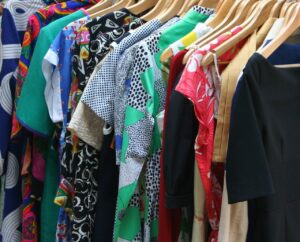 There they all are, just hanging there, smooshed together in the dark, waiting like Broadway wannabes after an audition. As I reach for the usual gray shorts and oversized t-shirt, I shoot them a guilty glance, admiring their colors. It seems so long ago that I spent a rainy afternoon sorting them, pinks into lavenders into blues, a color wheel of light summer dresses, long swirly skirts, and soft blouses. I straighten a twitchy hanger, stroke a silk sleeve with real affection.
There they all are, just hanging there, smooshed together in the dark, waiting like Broadway wannabes after an audition. As I reach for the usual gray shorts and oversized t-shirt, I shoot them a guilty glance, admiring their colors. It seems so long ago that I spent a rainy afternoon sorting them, pinks into lavenders into blues, a color wheel of light summer dresses, long swirly skirts, and soft blouses. I straighten a twitchy hanger, stroke a silk sleeve with real affection.
I miss my clothes.
Wardrobe is a casualty of the pandemic, at least for those of us able to work from home. But the meme that still cracks me up is the woman dressed in a ballgown, opera gloves, and tiara, announcing that she is ready to go fetch the mail. The few times I go somewhere other than the grocery store, I feel like I am getting ready for a ball. The preparations are slower, clumsier, more painstaking than they used to be; I have lost the rhythm. Mornings used to mean a swift assembly of the right bra, the right shoes, the right earrings for a particular dress. Now I stand there like somebody’s kid sister, peering at clothes that seem like costumes.
After just half a year, I am no longer at ease with my grown-up clothes. Any day now, I will slip on something I loved and find it no longer fits or even suits me, after this feral reprieve and all the stress cookies. Yet I miss what those clothes used to mean, the idea of them, the feel. The missing is not vanity; I am hardly a clotheshorse. But for that reason, most of what gathers static in my closet was selected with care and deliberation. The point was never to be stunning. But after spending my formative teenage years in a hideous drop-waist pleated navy jumper and pilgrim-collar white blouse, I like the challenge of picking out clothes that match my mood, my taste, my personality. “That is so you” is the best compliment; it means the clothes are not concealing (except for a few bulges) or pretending. The exterior matches the interior.
Matchy-matchy, a fashionista might say, her glossy lips turned down. It is seductively easy to scorn someone else’s fashion choices. Yet the pants that are “highwater” in one decade are “capri” in another, and “vintage” is an excuse for anything. Why criticize? One need not care about trends to care about clothes. Many of us choose ours almost as carefully as we choose friends—and they are far lower maintenance.
Maybe this is why retail therapy works: The emotional investment has a guaranteed return. Just sew on a button or give them a good wash, and all is forgiven. But shopping is itself a revealing exercise. The shirts I miss wearing the most—but refuse to wear to Schnucks or the dog park—are a pure white, sleeveless Piazza Sempione blouse with a ruffly V-neck, snagged at a resale shop, and a cornflower blue plaid Rails shirt ordered online at seventy percent off, boyish but soft as a petal against my skin. So I search regularly for Piazza Sempione and Rails, even though I can afford neither label unless more miracles occur. I do it because I can; because in the digital marketplace, with its sense of endless possibilities, sucks me in. And because the possibilities really are endless, I need a brand name to narrow my search.
This reminds me of the Episcopal church I once attended. The interim rector was a warm, wise, funny priest who happened to be a lesbian. So what did the search committee do when it was time to find the permanent rector? They looked for a woman who was a lesbian. One committee member told me so flat-out. Ignoring the salient qualities of warmth, wisdom, and wit, they looked instead for the brand.
Freud called the darker examples of this habit “repetition compulsion.” We repeat a situation over and over again, either reenacting what happened or recreating the setting in which it happened. When what is repeated was traumatic in the first place, the compulsion is an attempt to heal. When we are repeating something pleasant, I suspect it is more like magical thinking. Or gambling: I won that time! Surely I can win again? I will do everything the very same way ….
No wonder haute couture, which blossomed in seventeenth-century France because of its vivid, shimmering silks, later shifted the emphasis from textiles and handcraft to concept and design. Beginning in the mid-nineteenth century, the fashion industry organized itself into houses, each bearing a particular designer’s name. For those of us who cannot afford couture, the “name” is less a person than a brand, a line. We find one that feels like “us” and shop it relentlessly, disappointed more often than not.
Heraclitus could give a little lifestyle counsel here: You never step into the same river twice. Yet we look for the same steals, or we order an entrée we loved the last time and stomp out of the restaurant disconsolate because it does not taste right this time. It is just not the same. We are so eager to repeat our pleasure, greedy for more of the same, yearning for a guarantee.
Pleasure never gives one.
Read more by Jeannette Cooperman here.
